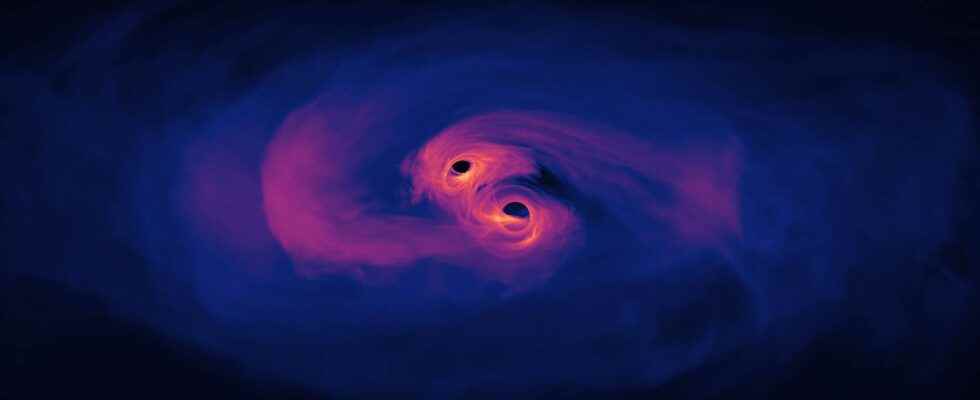Supermassive black holes are everywhere in the observable cosmos. They are sometimes found in pairs in a galaxy, to the point of forming a binary supermassive black hole. The closest known to date has just been found less than a hundred million light years from the Milky Way.
You will also be interested
[EN VIDÉO] The detection of gravitational waves will revolutionize our perception of the universe A century ago, Einstein predicted the existence of gravitational waves by his theory of general relativity. With their presence now known, scientists hope to study them in detail soon. Here is a video of two projects that would allow us to know a little more about these ripples of space-time.
There is no longer any doubt that the vast majority of galaxies are occupied at their center by a star compact which everything indicates that it is indeed a supermassive black hole. Caution is still required because, strictly speaking, if these objects are string balls or some wormholes, for example, and therefore, without event horizon, they are not real black holes according to the rigorous definition used by physicists since the work of the Nobel Prize Physical Roger penrose specifically.
The origin of these supermassive black holes remains a bit enigmatic but we have reason to believe that one of the growth factors of these objects is their fusion during galactic collisions. It is not obvious, however, that these galaxy mergers will systematically sediment their massive black holes at the center of the news. galaxy to the point that they fatally coalesce.
However, we are not only seeing galaxy mergers but also binary supermassive black holes in the final galaxy. We should know more about this when the eLisa gravitational wave detector will be in orbit around Sun by the 2035s.
Eso today makes an interesting announcement about these binary supermassive black holes by revealing that, thanks to the Very Large Telescope of the European Southern Observatory (VLT of ESO) and the Muse instrument (Multi-Unit Spectroscopic Explorer) which equips it at the Paranal Observatory in Chile, the closest pair of these objects known to date has been detected.
She is in the galaxy NGC 7727, in the constellation Aquarius, about 89 million light years from the Milky Way. As a bonus, they are also the least distant supermassive black holes known from each other with a relative distance of only around 1,600 light years.
A fusion of supermassive black holes in 250 million years
” This is the first time that we have found two supermassive black holes so close to each other, less than half the distance between the previous record holder. », Explains in the Eso press release Karina voggel, astronomer at the Strasbourg Observatory and lead author of the study published online today.
The two stars will therefore eventually merge into a single giant black hole as explained by Holger Baumgardt, professor at the University of Queensland, Australia and co-author of the publication in Astronomy & Astrophysics : ” The weak separation and the speed of two black holes indicate they will merge into one colossal black hole, likely within 250 million years “.
NGC 7727, itself, appears to be the product of a galactic collision that occurred around a billion years ago and it door still the stigmata of this event in the form of irregular structures and remnants ofstars produced by tidal forces. As for the black holes themselves, their effects on the movements of nearby stars indicate that the largest, located in the heart of the galaxy, weighs about 154 million mass solar but only 6.3 million for its companion. Remember that the one in our Galaxy contains about 4 million.
Using the Very Large Telescope from ESO, astronomers have revealed the closest pair of supermassive black holes to Earth ever observed. This video summarizes the discovery. To obtain a fairly accurate French translation, click on the white rectangle at the bottom right. The English subtitles should then appear. Then click on the nut to the right of the rectangle, then on “Subtitles” and finally on “Translate automatically”. Choose “French”. © European Southern Observatory (ESO)
Karina Voggel explains that this “ discovery implies that there could be many more of these remnants of galaxy mergers and that they could contain many hidden massive black holes still waiting to be discovered. This could increase by 30% the total number of known supermassive black holes in theUniverse local “.
This prediction should be able to be tested soon, as its other co-author Steffen Mieske, astronomer at ESO in Chile and responsible for ESO’s Paranal scientific operations, continues to explain in the Eso press release.
” Detecting this pair of supermassive black holes is just the start. With the Harmoni instrument on theELT, we will be able to make detections like this much further than is currently possible. THE’ELT of ESO will be an integral part of understanding these objects “.
This digital simulation brings astrophysicists one step closer to understanding the types of light signals produced when two supermassive black holes surrounded by matter, which are millions to billions of times the mass of the Sun, spiral into collision. This simulation fully incorporates the physical effects of Einstein’s General Theory of Relativity and it shows that the gas in such systems will primarily glow in ultraviolet light and x-rays. To get a fairly accurate English translation, click on the white rectangle at the bottom right. The English subtitles should then appear. Then click on the nut to the right of the rectangle, then on “Subtitles” and finally on “Translate automatically”. Choose “French”. © Nasa’s Goddard Space Flight Center
Interested in what you just read?
.
fs3
